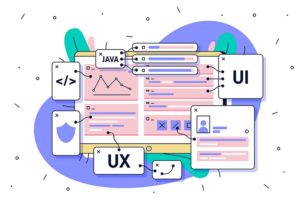React JS Training Course
- 23k Enrolled Learners
- Weekend
- Live Class
In the world of digital products, two design terms are often thrown around – UI and UX. UI stands for User Interface, while UX stands for User Experience. Although they sound similar, UI and UX design are two distinct disciplines with different objectives, methods, and outcomes. In this blog post on UI vs UX design, we will explore the differences between UI and UX design with the following
What is UI Design?
UI design refers to the visual and interactive elements that make up the interface of a digital product. The goal of UI design is to create an intuitive, user-friendly interface that allows users to interact with the product in a seamless way. UI designers focus on designing visual elements, such as buttons, icons, menus, typography, colours, and layout. They also consider interactive elements, such as animations, transitions, and feedback, to create a cohesive and engaging user experience.
UI designers need to have a good understanding of the target audience, the product’s purpose, and the brand’s identity. They should also be proficient in design tools, such as Sketch, Figma, or Adobe XD, and have a good understanding of design principles, such as balance, contrast, alignment, and hierarchy.
What is UX Design?
UX design, on the other hand, focuses on the overall experience of using a digital product. It encompasses all aspects of the user’s interaction with the product, including the user’s emotions, perceptions, and behaviours. The goal of UX design is to create a user-centred design that meets the user’s needs, solves their problems, and provides a delightful experience.
UX designers use various research methods, such as user interviews, surveys, usability tests, and analytics, to gather insights into the user’s needs, pain points, and behaviours. Based on these insights, they create user personas, user journeys, and information architecture to guide the design process. They also work closely with UI designers to ensure that the visual and interactive elements align with the user’s needs and expectations.
UI vs UX Design: What are the Key Differences?
Although UI and UX design are closely related, there are several key differences between the two disciplines.
| UI Design | UX Design |
| Focuses on designing the visual and interactive elements of digital products | Focuses on creating user-centered designs that solve user problems and provide a delightful experience |
| Involves creating the look and feel of the interface, such as typography, color, layout, and icons | Involves conducting research to understand user needs, behaviors, and pain points |
| Requires proficiency in design tools, such as Sketch, Figma, or Adobe XD | Requires proficiency in research methods, such as user interviews, surveys, and usability tests |
| Requires a good understanding of design principles, such as balance, contrast, alignment, and hierarchy | Requires a good understanding of information architecture, user personas, and user journeys |
| Involves creating design systems and style guides to ensure consistency and scalability | Involves conducting iterative design and testing to validate design solutions |
| Works closely with UX designers, developers, and product managers to ensure the interface aligns with the user’s needs and expectations | Works closely with UI designers, developers, and product managers to ensure the design aligns with the user’s needs and expectations |
| Can work in a wide range of industries, such as tech, e-commerce, entertainment, and healthcare | Can work in a wide range of industries, such as tech, finance, education, and non-profit |
| Can work as part of a design team or as a freelancer, offering greater flexibility and independence | Can work as part of a design team or as a freelancer, offering greater flexibility and independence |
| Requires staying up-to-date with the latest design trends and technologies | Requires staying up-to-date with the latest research methods and tools |
| Has a strong focus on aesthetics and visual appeal | Has a strong focus on usability and user satisfaction |
| Can involve working under tight deadlines and collaborating effectively with other team members | This can involve managing stakeholder expectations and navigating complex design challenges |
While there are some key differences between UI and UX design, both fields are important for creating successful digital products. UI designers focus on the visual and interactive elements of the interface, while UX designers focus on creating user-centred designs that solve user problems and provide a delightful experience. However, both fields require collaboration, attention to detail, and a deep understanding of the user’s needs and expectations. Ultimately, the best digital products are those that seamlessly integrate both UI and UX design principles to create a seamless, enjoyable user experience.
UI vs UX Design: How Do They Work Together?
Although UI and UX design are different disciplines, they are closely intertwined and work together to create compelling digital experiences. Here are some ways in which UI and UX designers collaborate:

Comparing UI and UX design careers and determining which one is “better” ultimately depends on individual interests, skills, and career goals. Both careers have their own unique challenges, opportunities, and benefits.
UI Design Career
UI design careers are primarily focused on designing the visual elements that make up the interface of digital products. UI designers need to have a good understanding of the target audience, the product’s purpose, and the brand’s identity. They also need to be proficient in design tools, such as Sketch, Figma, or Adobe XD, and have a good understanding of design principles, such as balance, contrast, alignment, and hierarchy.
One of the main benefits of a UI design career is the opportunity to create visually appealing and aesthetically pleasing digital products. UI designers can work in a wide range of industries, including tech, e-commerce, entertainment, and healthcare. They can also work as part of a design team or as a freelancer, offering greater flexibility and independence.
However, UI design careers can also be challenging. UI designers need to stay up-to-date with the latest design trends and technologies, as well as adapt their designs to different screen sizes and devices. They also need to be able to work under tight deadlines and collaborate effectively with other team members, such as UX designers, developers, and product managers.

UX Design Career
UX design careers are primarily focused on creating user-centered designs that meet the user’s needs, solve their problems, and provide a delightful experience. UX designers use various research methods, such as user interviews, surveys, usability tests, and analytics, to gather insights into the user’s needs, pain points, and behaviors. Based on these insights, they create user personas, user journeys, and information architecture to guide the design process. They also work closely with UI designers to ensure that the visual and interactive elements align with the user’s needs and expectations.
One of the main benefits of a UX design career is the opportunity to have a direct impact on the user’s experience and satisfaction with a digital product. UX designers can work in a wide range of industries, including tech, finance, education, and non-profit. They can also work as part of a design team or as a freelancer, offering greater flexibility and independence.
However, UX design careers can also be challenging. UX designers need to have strong analytical, problem-solving, and communication skills. They also need to be able to navigate complex design challenges and manage stakeholder expectations. Additionally, the research process can be time-consuming and require a significant investment of resources.
Which Career Path is Better?
Both UI and UX design careers offer unique opportunities and challenges, and determine which one is “better” ultimately depends on individual interests, skills, and career goals. Some designers may prefer the creativity and visual aspects of UI design, while others may enjoy the research and analytical aspects of UX design.

It’s also worth noting that many designers specialize in both UI and UX design, and there are career paths that allow for a combination of both skill sets. These designers are often referred to as “UI/UX designers” or “product designers” and are in high demand in the industry.
Conclusion
In conclusion, UI and UX design are two distinct disciplines with different objectives, methods, and outcomes. UI design focuses on the visual and interactive elements that make up the interface, while UX design focuses on the overall experience of using the product. Despite their differences, UI and UX designers work closely together to create compelling digital experiences that meet the user’s needs and expectations. By understanding the differences and synergies between UI and UX design, designers can create better products that are user-friendly, engaging, and delightful to use.
This brings us to the end of this blog on UI vs UX design. Hope I was able to clearly explain UI vs UX design.
If you want to get trained in UI UX Design and wish to develop interesting UIs on your own, then check out the UI UX Design Course offered by Edureka, Our UI/UX design course, curated by industry experts that will help you to master all its concepts.
Check out the Angular Online Course by Edureka, a trusted online learning company with a network of more than 250,000 satisfied learners spread across the globe. Angular is a JavaScript framework that is used to create scalable, enterprise, and performance client-side web applications. With Angular framework adoption being high, performance management of the application is community-driven indirectly driving better job opportunities.
Got a question for us? Please mention it in the comments section and we will get back to you.
 Thank you for registering Join Edureka Meetup community for 100+ Free Webinars each month JOIN MEETUP GROUP
Thank you for registering Join Edureka Meetup community for 100+ Free Webinars each month JOIN MEETUP GROUPedureka.co